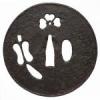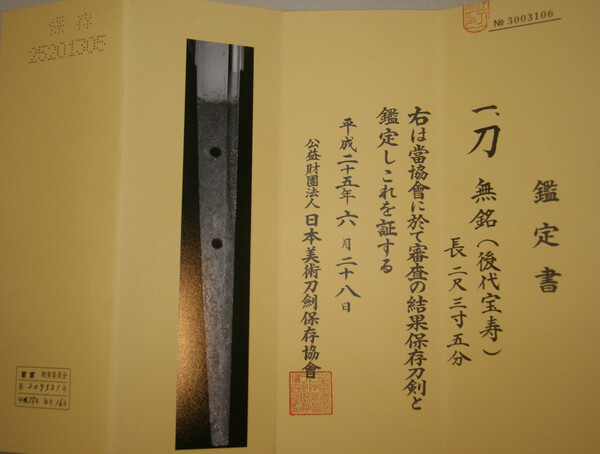-
Posts
1,271 -
Joined
-
Last visited
-
Days Won
1
Content Type
Profiles
Forums
Events
Store
Downloads
Gallery
Everything posted by hxv
-
Jean, Oh yes, I missed the kanji Ju. Hoanh
-
Davis, The mei reads "Bizen Kuni Osafune Munemitsu Saku." I can't read the last kanji below Saku. Do you have pictures of the sword and some close ups? Regards, Hoanh
-
Magnus, It's a Japanese sword cane, Shikomizue. Typically, the blades in these mountings are not high quality, but there are always exceptions to the rule. I would remove the handle to look at the tang. The hamon is visible in the pictures, but I can't see the hada because of the deep scratches. It's too bad the scabbard is missing. EDIT: Chris beat me to it! Regards, Hoanh
-
Richard, Both the tanto and picture are first rate Regards, Hoanh
-
Hi Adam, Yes, the soe hi is visible on both sides of the nakago. There are a lot of similarities between the Sanekage you posted and my sword. In fact, this had been one of Benson's initial guesses. It was a very good attribution on your part. I suppose the trouble with mumei swords is that there can be more than one plausible attribution. I think one can make an equally strong case (compared to Hoju) for Tametsugu, Sanekage, Ko Uda in general, or even Ko Hoki, as all of my reading of these schools/smiths point to Soshu-like characteristics of their works. In fact, I remember reading the theory that Norishige and Masamune tried to emulate Ko Hoki works in their creation of the Soshu tradition. I can try to dig up the reference if you are interested. In any event, it is a nice sword that I am glad to have restored. It's quite a pleasure to hold and study and admire in general. The elegant and graceful shape is quite pleasing as well. Regards, Hoanh
-
Thank you for the additional example, Veli. The sword from sanmei has a much closer resemblance (hada, hamon, and boshi) to my sword than the two examples I found. Regards, Hoanh
-
Hi Mariusz and All, I would like to thank all who have contributed to this thread. It was very educational for me. Marius: No offense is taken at all! My objective in this kantei game is to learn what others think and how they arrive at their conclusions, and as such, all comments are appreciated. First, on your comment that the hamon is nie deki. I would probably go along with ko-nie deki, as the nie particles are very, very fine. Second, on the o-mokume hada, I believe that's the hada the sword was forged with, as this hada is prominent throughout the length of the sword on both sides. The motokasane is still a healthy 7.5mm, although the motokasane is only 5.3mm as you noted. Regarding the kantei guesses posted, we have: Ko Uda, Etchu Tametsugu (Ko Uda), Uda, Shitahara, Mino Senjuin, and Hoju. It seems to me that the commonality between these attributions is the Soshu-like flavors, specifically in relation to Norishige (Ko Uda, Etchu Tametsugu). In particular, the matsukawa hada stands out. I did not use the term "matsukawa hada" in the description since I did not want to influence/bias people's thinking in anyway. Prior to polishing the sword, Bob Benson thought Ko Uda, Sanekage or Tametsugu. After polishing, he thought Ko Hoki. Again, I can see the commonality in Bob's attributions as the Soshu-like flavors. In any event, the sword clearly exhibits some Soshu-like flavors. As for the NBTHK attribution, "Kodai Hoju." So, a big cheer for Veli and Mariusz (he did give Hoju as his second choice). I found on the web a couple of swords attributed to Hoju, and would be interested in your thoughts. http://www.nihontocraft.com/Hoju_Nagina ... atana.html http://www.nihontoantiques.com/fss551.htm Regards, Hoanh
-
I just saw an item description on Ebay and had to share it with you. It just cracked me up. Hoanh
-
Keith, Just because a smith has no honorary title doesn't mean he is not a well regarded smiths. Honorary titles are just honorary titles - no more, no less. EDIT: I think what's more puzzling is not the lack of honorary title, but the lack of Province where the smith lived and made swords. With no honorary title, the usual mei, especially for daito with plenty of real estate to chisel long mei, is Province+Ju+Smith Name+Saku. It's unusual for a Shinto smith to chisel name+saku alone. Regards, Hoanh
-
Thank you Kunitaro san. BUMP! I will be posting the NBTHK Origami tomorrow morning, so please post your thoughts, gentlemen. Regards, Hoanh
-
Keith, Mass-produced swords (kazu uchimono) were made in the mid-late Muromachi jidai when feudal Japan was in a raging war and sword production had to keep up with demands. Your sword looks to be a Shinto sword, so not mass-produced. It may not be custom-made, but it's not mass-produced, either. Regards, Hoanh
-
Jacques, I know That's why I said it perplexes me. Hoanh
-
KM, No, not just in terms of monetary value. The boshi is a very important part of the "art" aspect of a sword. I suppose it all depends on what one collects. If one collects historical artifacts, then one can certain choose to restore this sword. If one collects art swords, then this sword probably will not fit the bill. There is not a right or wrong answer. It just depends on what the collector in question wishes to collect. Most of us are working folks with finite financial resources. So, I would say monetary values are always a concern - at least for me. This issue is always part of the equation for me. Regards, Hoanh
-
KM, Even though one can always reshape the kissaki, without the boshi, a sword is worthless unless it's a Nanbokucho or earlier tachi. This sword looks to be Muromachi, so probably best to leave as is. Regards, Hoanh
-
Dennis, It looks like a kazu uchimono uchigatana. The mei seems to read Bishu Osafune ... EDIT: The tachi mei perplexes me. Regards, Hoanh
-
Dear Kunitaro san, As you can see in the pictures, there are lots of activities in the hamon. However, the nie are so fine that I think of them as nioi. So, I would say nioi deki. Sorry for the misspelling, Kunitaro san. Regards, Hoanh
-
George, I can make out the last four kanji as "Hiromitsu Saku Kore." Regards, Hoanh
-
Keith, If you wish to research the sword, search on the web to see papered, signed swords by the same smith. Then, look at the signatures on your sword versus the known, papered examples to see if the kanji strokes, placement of the kanji relative to the mekugi ana, nakagojiri, yasurime, and nakago shape are consistent. Sometimes, you will encounter 'gimei,' meaning although the sword is genuine nihonto, the signature is false. I have no way of knowing if this is the case with your sword since I have not done the research. It's standard due diligence whenever one contemplates buying a signed sword. I strongly recommend this exercise. For me, it's very fun and I learn more about the sword smith in the process. Along the way, you will most likely read about the smith and how his works are ranked and what kind of prices his swords, papered and restored, will fetch. It will give you tools to make an informed decision regarding how you might want to proceed with your sword. It takes time and patience, but is extremely rewarding. Regards, Hoanh
-
Keith, There are couple of recommendations I think seasoned members of this board will approve: John Tirado and Brian Tschernega. Brian charges $650 for katana shirasaya and John charges $500. These prices are as of three weeks ago, so they are current. Just drop them an email, they will give you shipping instructions and time estimates - anywhere from 3 to 6 months. John Tirado: john@sayashi.com Brian: habaki73@comcast.net Regards, Hoanh
-
Thunder, The picture size needs to be less than 1200x1200. Here is the how-to link viewtopic.php?f=8&t=8 Regards, Hoanh
-
Keith, Yes, at that length, it's katana-size. The blade already has a shirasaya, e.g., the wood storage case shown in the picture. Personally, I wouldn't sink anymore money into the sword. If you did, you wouldn't recover additional money spent when it's time to sell. My advice is to clean the blade (not the tang) with isopropyl alcohol to get rid of any residue and to keep the blade form rusting away and enjoy it for what it is. When it's time to sell, you would make a handsome profit and use the proceed to buy some books on nihonto. Regards. Hoanh
-
Depending on the length of the cutting edge, the price will vary. I would guess ~$400 (wakizashi) or ~$700 (katana). Hoanh
-
Yes, it is a nihonto - antique, hand-made, water-quenched the traditional way...the works. For $80, you did very, very well. What to do with it now is another issue entirely. Regards, Hoanh
-
I concur with Brian. The placement of the nakago ana is wrong, and the nakago jiri is wrong as well. Hoanh



